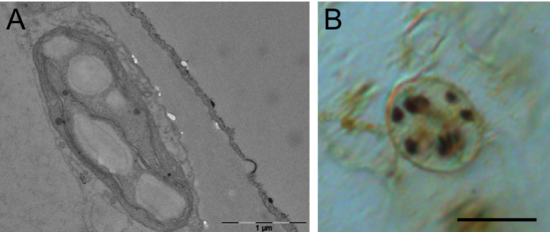The role of carbon metabolism in drought stress tolerance
Plant Molecular Physiology and Biochemistry
Our lab is interested in understanding the molecular mechanisms of carbon partitioning (between starch and sugars) at different stages of water deficit.
In the case of mild water stress, the partial closure of stomata can be sufficient to sustain plant performance, thus making guard cells a putative target to engineer drought avoidance in plants with minimal alterations of yield. We employ a diverse array of molecular and biochemical approaches to investigate the contribution of starch and sucrose metabolism in the regulation of stomatal movement in Arabidopsis guard cells over the diurnal cycle and in response to water deficit.
In case of more severe stress, one of the most important mechanisms of drought resistance is the accumulation of soluble sugars to avoid water loss and to protect membranes, enzymes and other structures against damage and denaturation. To identify the precise metabolic origin of the increased sugar pool and the way the stress-induced reprogramming of carbon metabolism is regulated, we perform 14CO2 “pulse-chase” experiments in Arabidopsis wild type plants and a set of starch/sucrose-related mutants exposed to different levels of water stress.
Research topics
- Carbohydrate metabolism
- Guard cells
- Drought/desiccation tolerance
Recent Publications
Arabidopsis Sucrose Synthase 3 (SUS3) regulates starch accumulation in guard cells at the end of day
Lucia Piro Sabrina Flütsch Diana Santelia
Plant Signaling & Behavior 18(1) Feb 2023- Effective root responses to salinity stress include maintained cell expansion and carbon allocation
Li, HF; Duijts, K; (...); Testerink, C
New Phytologist 238 (5) , pp.1942-1956 Jun 2023 - Starch biosynthesis in guard cells has features of both autotrophic and heterotrophic tissues
Flutsch, S; Horrer, D and Santelia, D
Plant Physiology 189 (2), pp.541-556 Jun 1 2022 - Glucose uptake to guard cells viaSTPtransporters provides carbon sources for stomatal opening and plant growth
Fluetsch, Sabrina; Nigro, Arianna; Conci, Franco; Fajkus, Jiri; Thalmann, Matthias; et al.
Embo Reports 10.15252/embr.201949719 AUG 5 2020 - Guard Cell Starch Degradation Yields Glucose for Rapid Stomatal Opening in Arabidopsis
Fluetsch, Sabrina; Wang, Yizhou; Takemiya, Atsushi; Vialet-Chabrand, Silvere R. M.; Klejchova, Martina; et al.
Plant Cell 10.1105/tpc.18.00802 JUL 2020 - Glucose uptake to guard cells viaSTPtransporters provides carbon sources for stomatal opening and plant growth
Fluetsch, Sabrina; Nigro, Arianna; Conci, Franco; Fajkus, Jiri; Thalmann, Matthias; et al.
Embo Reports DOI: 10.15252/embr.201949719 AUG 5 2020 - Guard Cell Starch Degradation Yields Glucose for Rapid Stomatal Opening in Arabidopsis
Fluetsch, Sabrina; Wang, Yizhou; Takemiya, Atsushi; Vialet-Chabrand, Silvere R. M.; Klejchova, Martina; et al.
Plant Cell DOI: 10.1105/tpc.18.00802 JUL 2020 - Peeling back the layers of crassulacean acid metabolism: functional differentiation between Kalanchoe fedtschenkoi epidermis and mesophyll proteomes
Abraham, Paul E.; Castano, Natalia Hurtado; Cowan-Turner, Daniel; Barnes, Jeremy; Poudel, Suresh; et al.
Plant Journal DOI: 10.1111/tpj.14757 JUL 2020 - Salinity in Autumn-Winter Season and Fruit Quality of Tomato Landraces
Moles, TM; Francisco, RD; Mariotti, L; Pompeiano, A; Lupini, A; Incrocci, L; Carmassi, G; Scartazza, A; Pistelli, L; Guglielminetti, L; Pardossi, A; Sunseri, F; Hortensteiner, S; Santelia, D
FRONTIERS IN PLANT SCIENCE, 10 10.3389/fpls.2019.01078 SEP 24 2019 - The Thioredoxin-Regulated alpha-Amylase 3 of Arabidopsis thaliana Is a Target of S-Glutathionylation
Gurrieri, L; Distefano, L; Pirone, C; Horrer, D; Seung, D; Zaffagnini, M; Rouhier, N; Trost, P; Santelia, D; Sparla, F
FRONTIERS IN PLANT SCIENCE, 10 10.3389/fpls.2019.00993 JUL 31 2019 - The evolution of functional complexity within the β-amylase gene family in land plants
Thalmann M; Coiro M; Meier T; Wicker T; Zeeman SC; Santelia D
BMC EVOLUTIONARY BIOLOGY, 19 10.1186/s12862-019-1395-2 FEB 28 2019 - …

PD Dr. Diana Santelia
ETH Zurich
Institute of Integrative Biology
8092 Zurich
Phone: +41 44 632 89 27
Links
Interdisciplinary
- Plant biochemistry and physiology
- Molecular genetics
- Cell biology

